Gravity: Down to Earth
Grade 7
Presentation
Hypothesis
If we use a longer drop then we can measure the acceleration of gravity more accurately because it eliminates some of the experimental error due to reaction time.
Research
The acceleration of gravity was first discovered by Galileo; he discovered it from dropping objects off the Leaning Tower of Pisa. Galileo proved that objects of different masses fall at the same acceleration. The acceleration of gravity on Earth is 9.8m/s/s. The acceleration of gravity is the acceleration of any object under the influence of gravity. The acceleration of gravity can be used to calculate the net force acting on an object and obviously its acceleration.
One of the ways you can measure the acceleration of gravity is by dropping a mass from a certain height and timing it from release to contact with the ground. One of the other ways you can measure the acceleration of gravity is by measuring the period of oscillation with a pendulum. The period of a pendulum is the amount of time it takes from the starting position to the other side and back. The formula for the pendulum experiment is a= 4π²l divided by t² (l)
Differences between gravity and the acceleration of gravity:
Gravity is a force that pulls objects into the center of a mass.
The acceleration of gravity is the acceleration on a free falling object because of Earth's gravitational pull.
Human reaction time is 250ms
Variables
Water Drop Test
Manipulated Variable: The height of the burette
Responding Variable: The calculated acceleration of gravity
Controlled Variables: The burette, Timer/Stopwatch, Number of drops per trial
Pendulum Test
Manipulated Variable: The Length of string
Responding Variable: A more accurate result to the acceleration of gravity
Controlled Variables: The bob at the end of the string, The amount of cycles
Procedure
Water Drop Test
First you will set up the burette at the height of testing with a small bowl underneath and next fill the burette with water using a funnel. Measure the distance between the tip of the burette and the bottom of the bowl. We did three different heights: 1.763 m, 0.961 m, and 0.489 m. Turn the valve on the burette so that once one water droplet hits the bottom of the bowl the next one starts to drop. Time with a timer/stopwatch the amount of time it takes for fifteen drops to hit the bottom of the bowl. We did nine trials at each height. To do the calculations divide the total time measured by the number of drops to get the time per drop (t). Use the formula 2d divided by t² (d) being distance and (t) being time per drop
Pendulum Test
The first step of this experiment is to set up a retort stand over a ledge. You will want to attach the size string that you are using to the stand and connect a bob to the end of that string. I used five different lengths: 0.132 m, 0.448 m, 0.526 m, 1.116 m, and 1.707 m. You hold the bob up about fifteen degrees from the retort stand, making sure the string is tight then you let go of the bob trying not to apply any extra force. Start a timer/stopwatch and time the amount of time it takes for the bob to make five oscillations. I did ten trials for each length of string. To do the calculations you will use the formula a= 4π²l divided by t² (l) being length and (t) being seconds/cycle.
Observations
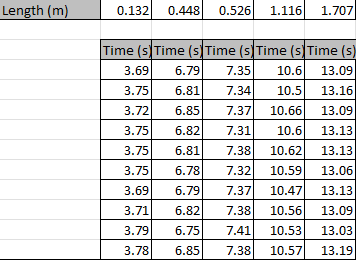 I measured the time for five different lengths of string. I did ten trials with each length of string. I observed for this experiment that the longer the string the easier it was to start/stop the stopwatch. When I dropped the string with the bob I noticed that on some of the trials it would change direction to back and forth instead of side to side. On the shortest string I noticed that I would mis-count quite often.
I measured the time for five different lengths of string. I did ten trials with each length of string. I observed for this experiment that the longer the string the easier it was to start/stop the stopwatch. When I dropped the string with the bob I noticed that on some of the trials it would change direction to back and forth instead of side to side. On the shortest string I noticed that I would mis-count quite often.
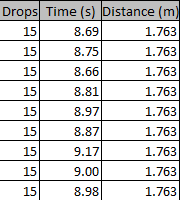 I measured the distance from the tip of the burette to the ground three times. I did nine trials with fifteen drops each. When doing this experiment I noticed it was quite hard to get the flow of the water exactly how it should be. I found it was useful to tap my foot on the ground on beat with the water so I could start and stop the stopwatch on time. On the shortest drop I found it hard to get the stopwatch to start and stop at the right time.
I measured the distance from the tip of the burette to the ground three times. I did nine trials with fifteen drops each. When doing this experiment I noticed it was quite hard to get the flow of the water exactly how it should be. I found it was useful to tap my foot on the ground on beat with the water so I could start and stop the stopwatch on time. On the shortest drop I found it hard to get the stopwatch to start and stop at the right time.
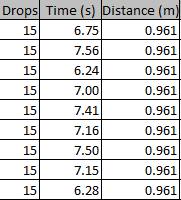
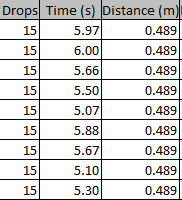
Analysis
Pendulum Test
Using the small angle approximation the acceleration of gravity for a pendulum is given by the formula below.
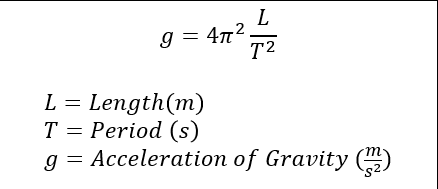

The following constants are used in the calculations below.
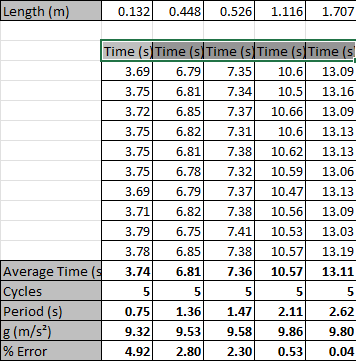
The period was found by dividing the average total time by the number of cycles. Using the length of the string (L) and the period (T) the acceleration of gravity was calculated. The percent error was calculated using the absoulute value of the difference between the accepted value and the experimental value divided by the accepted value. The percent error was plotted with respect to the length of the string and is shown below.
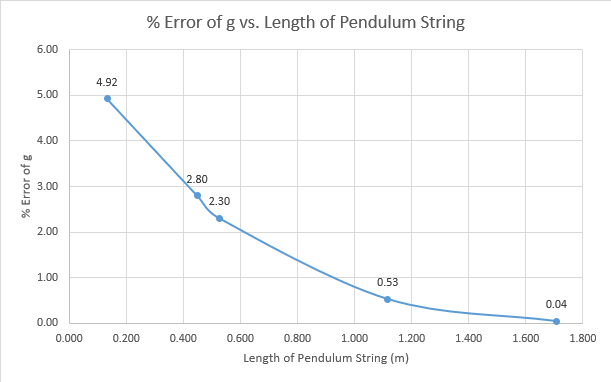
Water Drop Test
Assuming an initial velocity and distance of zero, the acceleration can be found using the equation below.
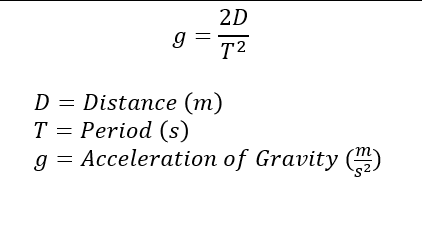

The following constant is used in the calculations below.
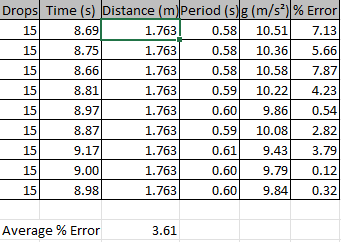
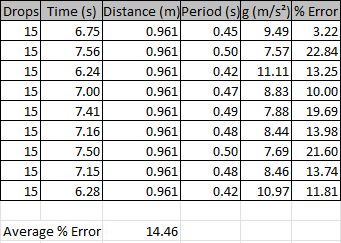
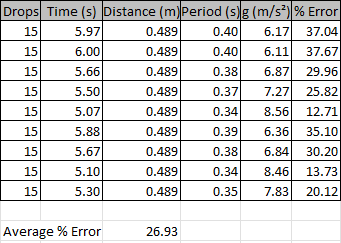
The period is calculated by dividing the total time by the number of drops. Using the distance (D) and the period (T) the experimental value of the acceleration of gravity is calculated. The percent error was calculated using the absoulute value of the difference between the accepted value and the experimental value divided by the accepted value. The percent error was plotted with respect to the length of the string and is shown below.
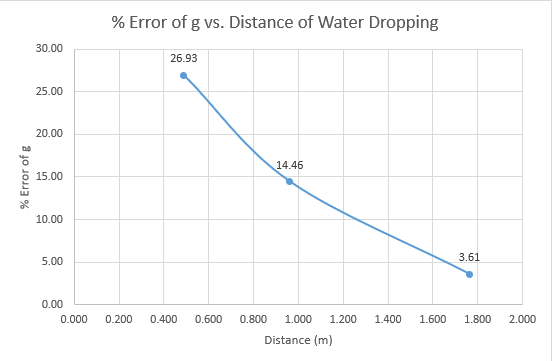
Conclusion
An experiment was conducted using a weight attached to a string to form a pendulum. As the length of the string was varied the acceleration of Earth’s gravity was calculated from the measured period of oscillation. As the string increased in length the accuracy of the acceleration of gravity was improved. I conducted another experiment using water dripping from a burette from a variety of heights from the floor. The acceleration of gravity was calculated from the measured time the water drop fell. As the height of the burette increased the accuracy of the acceleration of gravity was improved. These experiments prove the hypothesis that an increase in length and distance will improve the overall accuracy of the measurement. I originally believed that reaction time was causing there to be inaccurate results but then later learned it did not affect my results because it cancels itself out. About the same reaction happens when I start the timer as when I stop it.
Application
This is a useful experiment for teachers to demonstrate that you can use household materials to measure the acceleration of gravity. Teachers can do this experiment in a classroom or you can do it at home.
Next time I do an experiment like this I would like to do more trials to see if that gives me a more accurate result. I might try next time to use a variety of different distances. I might try dropping an object from somewhere up high like Galileo did.
Sources Of Error
There are several sources of error in this experiment including:
Water Drop Test
It would be hard to judge the flow of water exactly. You will not be able to start/stop the stopwatch at exactly the right time (reaction time). You may get an inaccurate measurement from the tip of the burette to the ground
Pendulum Test
It is possible that you apply extra force when letting the bob drop. You won't be able to start/stop the stopwatch at exactly the right time (reaction time). Friction is an outside force acting upon the test when we're only looking for the acceleration of gravity.
Citations
Acceleration due to Gravity. (2021, March 24). GeeksforGeeks. https://www.geeksforgeeks.org/acceleration-due-to-gravity/
Dusto, A. (2020, December 22). Gravity (Physics): What Is It & Why Is It Important? Sciencing. https://sciencing.com/gravity-physics-what-is-it-why-is-it-important-13721031.html
Galileo’s famous gravity experiment holds up, even with individual atoms. (n.d.). Washington Post. https://www.washingtonpost.com/science/galileos-famous-gravity-experiment-holds-up-even-with-individual-atoms/2020/10/30/f6088c64-19f5-11eb-aeec-b93bcc29a01b_story.html
How Do You Measure the Strength of Gravity? (2023). NIST. https://www.nist.gov/how-do-you-measure-it/how-do-you-measure-strength-gravity#:~:text=To%20measure%20little%20g%2C%20scientists
How to Calculate the Acceleration due to Gravity using the Pendulum Equation (2022). Study.com.
The Physics Classroom. (2019). Acceleration of Gravity. Physicsclassroom.com; The Physics Classroom. https://www.physicsclassroom.com/class/1DKin/Lesson-5/Acceleration-of-Gravity
Acknowledgement
I would like to thank Mr. Hauk and Ms. James for running the science fair club at my school and signing me up for the CYSF. My father was a big help in my project as he helped me run the experiments and paid for the equipment. I would also like to thank the people running the CYSF as I couldn't do this if they didn't run it.

